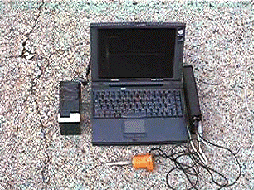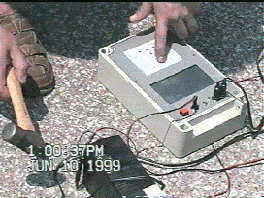



Theoretical basis
The RAP method is the result of the study of natural geophysical fields. It is an
inexpensive method, mainly, because it does not require cumbersome excitation sources as, for
instance, the ground-penetrating radar The instruments based on this method registers the
natural acoustic field of the Earth, i.e. the acoustic resonance field induced in rocks in
response to various external factors. The external factors include crust seismic activity
sources, mechanical oscillations resulting from earth tensions, planet movement, man-made
vibrations, and many others. In rocks, in response to external factors, oscillations of
a frequency inversely proportional to the thickness of an oscillating "layer" are
developed. in the generated imagery, between the resonator layers result from a "sliding"
(or displacement) of adjacent layers relative to each other, this "sliding" being involved
in the elastic shift process in the rocks under study. In other words, these boundaries
have a degree of contrast depending on how "weak" the contact between the layers is. By
a "layer" is meant a thickness of rocks between the surface where measurements are
made measurements and the "weak mechanical contact" (WMC) surface.
The WMC surface is a result of:
The weaker the contact, the higher is the possibility of the "sliding"
of adjacent layers and, therefore, the higher is the amplitude of natural oscillations. An
artificial enhancement of natural oscillation amplitude is possible by means of small shock
excitation As a rule, a simple hammer strike on the ground surface will suffice for this purpose.
- abrupt changes in rock lithology,
- differences in the composition of rock strata (coal, clay, mica, etc.),
- pauses in sedimentation cycles,
- contacts with intrusive and extrusive rocks,
- faulting,
- sedimentary cover/crystalline basement and overburden/sedimentary cover boundaries.
Equipment
These physical principles define the parameters of the instrument based
on the RAP-method. Its function consists in the recording an acoustic signal, storing its spectral
components, and the spectral analysis of the recorded signal. Currently, the prototype equipment
is available in two models: the "RAP" version model includes an acoustic wave sensor of special
configuration, an analog-to-digital converter (ADC) and a Notebook PC/AT 486.
 The acoustic sensor is designed
and conFigured in such a way that the amplitude, frequency, and spectral characteristics of the
electrical signal are completely identical to the acoustic signal at the point where the acoustic
sensor contacts the ground surface.
The acoustic sensor is designed
and conFigured in such a way that the amplitude, frequency, and spectral characteristics of the
electrical signal are completely identical to the acoustic signal at the point where the acoustic
sensor contacts the ground surface.
The ADC designed for the RAP application employs a 16-bit ADSP2181 EZ-KIT Lite ADC manufactured by Analog Devices, Inc. and features high sensitivity. Its dynamical and frequency ranges allow digitization of all information contained in a received signal. The ADC provides 4 sampling frequencies (from 1000 to 48000 Hz), permitting operation to depths of 13 cm to 300 m without signal quality losses.
The Notebook PC provides:
The more advanced model, the RAP-Plus instrument comprises the same
parts, but does not use a PC for data storage. It includes a power-independent memory, which can store
512 to 2048 information units (points of measurement). In addition, power consumption is 10 times
lower compared to the RAP model. This feature allows operation for about 3 days within a temperature range of - 20 to +4oC without recharging
the battery. It provides more sampling frequencies (6 ranges from 500 to 28000 Hz), permitting selection of
signal recording parameters depending on the problem to be solved. In addition, a longer duration of a
received signal is accommodated to attain an operating depth of 2000 m. The LCD front-panel and the
built-in keyboard allow the monitoring and changes in the survey parameters, as well as an immediate
assessment of the quality of obtained information. Modifications made in the circuitry and the sensor
design have resulted in a better noise-rejection characteristics, thus permitting operation under most
unfavorable conditions. The RAP-Plus model allows for real-time operation, so that an operator can
assess the spectral characteristics of a received signal and, if need be, promptly change survey
parameters right on the spot. The equipment is light and easy to operate by a single person. Cost of one
complete set of equipment for sale in Russia today is 8 000 - 10 000 $ US, depending on a complete set.
For foreign clients equipment cost can be changed.
This feature allows operation for about 3 days within a temperature range of - 20 to +4oC without recharging
the battery. It provides more sampling frequencies (6 ranges from 500 to 28000 Hz), permitting selection of
signal recording parameters depending on the problem to be solved. In addition, a longer duration of a
received signal is accommodated to attain an operating depth of 2000 m. The LCD front-panel and the
built-in keyboard allow the monitoring and changes in the survey parameters, as well as an immediate
assessment of the quality of obtained information. Modifications made in the circuitry and the sensor
design have resulted in a better noise-rejection characteristics, thus permitting operation under most
unfavorable conditions. The RAP-Plus model allows for real-time operation, so that an operator can
assess the spectral characteristics of a received signal and, if need be, promptly change survey
parameters right on the spot. The equipment is light and easy to operate by a single person. Cost of one
complete set of equipment for sale in Russia today is 8 000 - 10 000 $ US, depending on a complete set.
For foreign clients equipment cost can be changed.
RAP data processing and interpretation
The RAP-method obtains information on the mechanical properties of a geological section under study. If the geological conditions of the region are known, the geological-geophysical interpretation of obtained RAP data can be carried out. The RAP data processing consists of several stages and includes the computation of spectral characteristics of a signal received at each point of measurements using fast Fourier transform, the point-to-point correlation and the structure of the geomechanical profile. Additional signal processing consists in the filtering of spectral components (elimination of the electro-magnetic and instrumental noise), computation of the trend and the residual component , and the visualization of the obtained results. According to the RAP-method theory, the weakest mechanical contacts of a geological section produce peaks of spectral components. In the resulting image each amplitude of RAP-signal corresponds to a certain color of the color scale.By selecting the colors, the most informative boundaries of the section can be emphasized. The comparison of RAP cross-sections with drilling data shows that practically all geological boundaries located by drilling are present in RAP cross-sections of the profile. Moreover, drilling cannot locate a number of geomechanical boundaries, which RAP does locate. It should be emphasized that the RAP method provides information on the MECHANICAL structure of a geological section. In MOST CASES, mechanical structures coincide with geological structures. As for the weak mechanical contacts in a rock of a uniform composition, they are also easily located by the RAP method, but, as a rule, cannot be located by drilling. Profiles are corrected for terrain enabling a more accurate geological- geophysical interpretation of the obtained results. The phase-frequency characteristics of a signal are obtained using the RAP software. Geomechanical cross-sections are processed and constructed with the help of the "PRIMA" computer-aided geophysical data processing and visualization system. Finally, geomechanical RAP cross-sections of all lines are compiled.